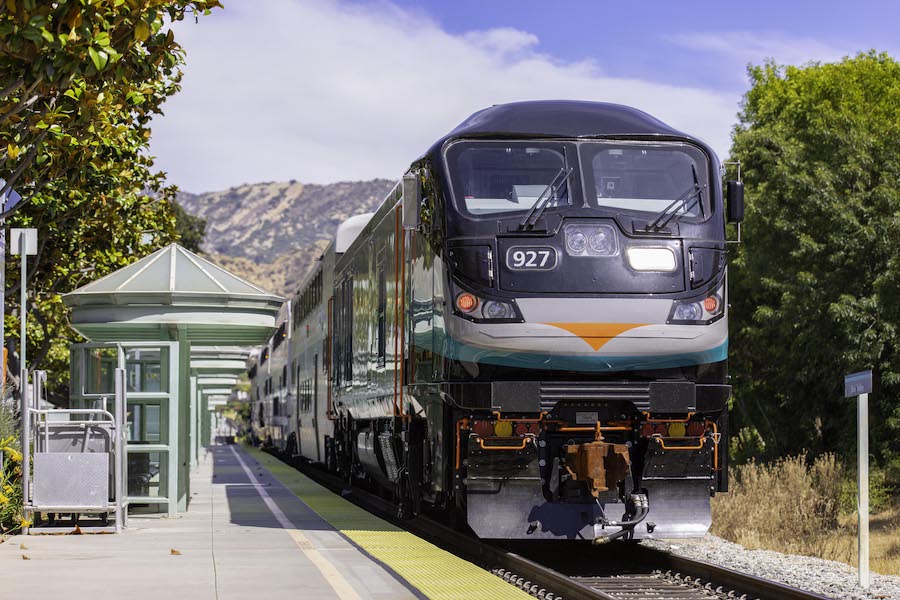The effects of climate change and impending global sporting events are keeping California agencies busy with multiple major infrastructure projects. Officials are aiming to build “legacy” infrastructure in the state that will continue to serve its denizens after the 2026 World Cup and 2028 Olympics.
Unlike previous host cities, Los Angeles “is not getting one dollar for transportation” for the Olympics, said Kasey Shuda, senior director of special projects for Los Angeles Metro’s 2028 Olympics Task Force. “We’re hustling for every dollar we can” from federal programs, she said, speaking at Infraday on April 18 in downtown Los Angeles.
Metro will create a special temporary route network specifically for Olympic athletes and staff, including procuring 2,700 additional buses. “Every other project will be a legacy project,” she said. Metro is considering putting out a project management support contract for a borrowed bus program, she added..
Tasha Higgins, principal transportation engineer with the California Dept. of Transportation and its LA28 district liaison, added that the agency is working with the Federal Highway Administration on temporarily implementing high-occupancy vehicle or high-occupancy toll lanes as well as syncing up traffic signals.
Preparing for such big deadlines is driving agencies to utilize alternative contracting methods, including task order contracting, said Emery Molnar, deputy executive director of Los Angeles World Airport’s development program. The agency is trying to be an "easy owner” who pays promptly and ensures fair competition, she said.
The shortage of workforce continues to be a challenge. “We are reaching out to all levels of firms—small, medium, large,” she added, noting that LAWA has an apprenticeship program in its project labor agreement.
Meeting Environmental Goals
The 2022 Inflation Reduction Act has incentivized public agencies to invest in renewable energy projects because they can file for tax credits, said Chris Livingstone, principal with CohnReznick, a business advisory firm. For example, LAWA can get money back for installing dynamic glass in terminals.
The Metropolitan Water District of Southern California is trying to revamp its 95-year-old system to adapt to climate change without overly burdening its customers with higher rates, said Mai Hattar, MWD’s assistant group manager for engineering. One of its key projects is a $6.4-billion effort to treat pure water, and it also has a buying mandate for 50% of its vehicles to be zero-emission.
Metrolink has embarked on a $10-billion project to improve its signals, 67 stations and fleets, with the goal of achieving 30-minute headways for commuters, said Jeraldine Otero, rail civil engineer with Metrolink. The Port of Long Beach is also focusing on rail, with 53% of its capital program for fiscal year 2024 dedicated to it at $154 million, and $1.6 billion to be spent over the next decade, said Sunny Zia, the port’s senior civil engineer.
The Port of Los Angeles is embarking on a $2-billion capital program, including a $200-million, 80-acre storage site, a $40-million grade separation project, and wharf improvements, said Dina Aryan-Zahlan, the port’s deputy executive director. It recently completed a $77-million project to make its Wilmington waterfront a public attraction. The port is also developing a $150-million workforce training center.
Further north, the Port of San Francisco must repair its 3-mile seawall in the face of an anticipated 3.5-ft sea level rise, said Dan Hodapp, senior waterfront planner. The port also plans to increase its waterfront electric capacity, adding up to an additional 100 MW.
Nearby, the San Francisco Bay Ferry is leasing a fuel-cell-powered ferry in a test pilot as part of ongoing efforts to electrify its network, said Seamus Murphy, the agency’s executive director. Water vapor generated by the fuel cells could be reused as drinking water, he added. However, currently models of fuel cells are still too heavy for longer ferry routes, he noted.
Aryan-Zahlan added that her port along with Long Beach is submitting for a $500-million grant for a hydrogen fuel initiative that could expand a “gas station” network.
MWD is also working with the LA Sanitation District on efforts to reuse and recycle water up to 150 million gallons a year, said John Shamma, section engineer. The agency plans to release desalination research contracts.
“We are secretly an electric company,” he said, noting pumping plants and 240 miles of high-voltage power lines that deliver water from the Hoover Dam. The challenge is how to harness solar energy but handle the excess without “giving it away,” he said.





